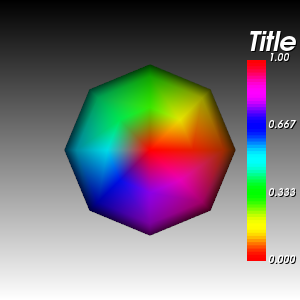ScalarBarActor
vtk-examples/Java/Visualization/ScalarBarActor
Description¶
This example demonstrates how to make a color bar to that reflects the range of values associated with a data set.
vtkScalarBarActor object creates a scalar bar with tick marks. A scalar bar is a legend that indicates to the viewer the correspondence between color value and data value. The legend consists of a rectangular bar made of rectangular pieces each colored a constant value.
Other languages
See (Cxx)
Question
If you have a question about this example, please use the VTK Discourse Forum
Code¶
ScalarBarActor.java
import vtk.vtkActor;
import vtk.vtkNamedColors;
import vtk.vtkNativeLibrary;
import vtk.vtkPolyDataMapper;
import vtk.vtkRenderWindow;
import vtk.vtkRenderWindowInteractor;
import vtk.vtkRenderer;
import vtk.vtkSphereSource;
import vtk.vtkFloatArray;
import vtk.vtkPolyData;
import vtk.vtkScalarBarActor;
import vtk.vtkLookupTable;
public class ScalarBarActor
{
// -----------------------------------------------------------------
// Load VTK library and print which library was not properly loaded
static
{
if (!vtkNativeLibrary.LoadAllNativeLibraries())
{
for (vtkNativeLibrary lib : vtkNativeLibrary.values())
{
if (!lib.IsLoaded())
{
System.out.println(lib.GetLibraryName() + " not loaded");
}
}
}
vtkNativeLibrary.DisableOutputWindow(null);
}
// -----------------------------------------------------------------
public static void main(String s[])
{
vtkNamedColors colors = new vtkNamedColors();
//For Background Color
double Bgcolor[] = new double[4];
//Renderer Background2 Color
double Bgcolor2[] = new double[4];
colors.GetColor("White", Bgcolor);
colors.GetColor("Black", Bgcolor2);
// Create a sphere for some geometry
vtkSphereSource sphere = new vtkSphereSource();
sphere.SetCenter(0,0,0);
sphere.SetRadius(1);
sphere.Update();
// Create scalar data to associate with the vertices of the sphere
int numPts = sphere.GetOutput().GetPoints().GetNumberOfPoints();
vtkFloatArray scalars = new vtkFloatArray();
scalars.SetNumberOfValues( numPts );
for( int i = 0; i < numPts; ++i )
{
scalars.SetValue(i,(float)(i)/numPts);
}
vtkPolyData poly = new vtkPolyData();
poly.DeepCopy(sphere.GetOutput());
poly.GetPointData().SetScalars(scalars);
vtkPolyDataMapper mapper = new vtkPolyDataMapper();
mapper.SetInputData(poly);
mapper.ScalarVisibilityOn();
mapper.SetScalarModeToUsePointData();
mapper.SetColorModeToMapScalars();
vtkActor actor = new vtkActor();
actor.SetMapper(mapper);
vtkScalarBarActor scalarBar = new vtkScalarBarActor();
scalarBar.SetLookupTable(mapper.GetLookupTable());
scalarBar.SetTitle("Title");
scalarBar.SetNumberOfLabels(4);
// Create a lookup table to share between the mapper and the scalarbar
vtkLookupTable hueLut = new vtkLookupTable();
hueLut.SetTableRange (0, 1);
hueLut.SetHueRange (0, 1);
hueLut.SetSaturationRange (1, 1);
hueLut.SetValueRange (1, 1);
hueLut.Build();
mapper.SetLookupTable( hueLut );
scalarBar.SetLookupTable( hueLut );
// Create the renderer, render window and interactor.
vtkRenderer ren = new vtkRenderer();
vtkRenderWindow renWin = new vtkRenderWindow();
renWin.AddRenderer(ren);
vtkRenderWindowInteractor iren = new vtkRenderWindowInteractor();
iren.SetRenderWindow(renWin);
// Visualise
ren.GradientBackgroundOn();
ren.AddActor(actor);
ren.AddActor2D(scalarBar);
ren.SetBackground(Bgcolor);
ren.SetBackground2(Bgcolor2);
renWin.SetSize(300, 300);
renWin.Render();
iren.Initialize();
iren.Start();
}
}
